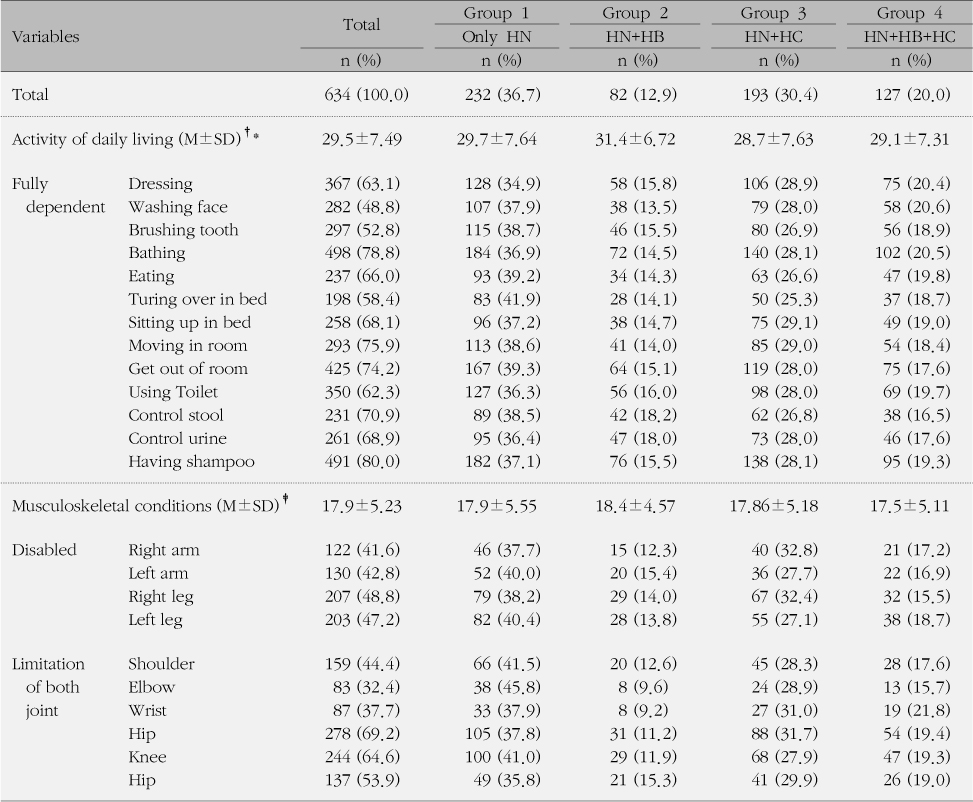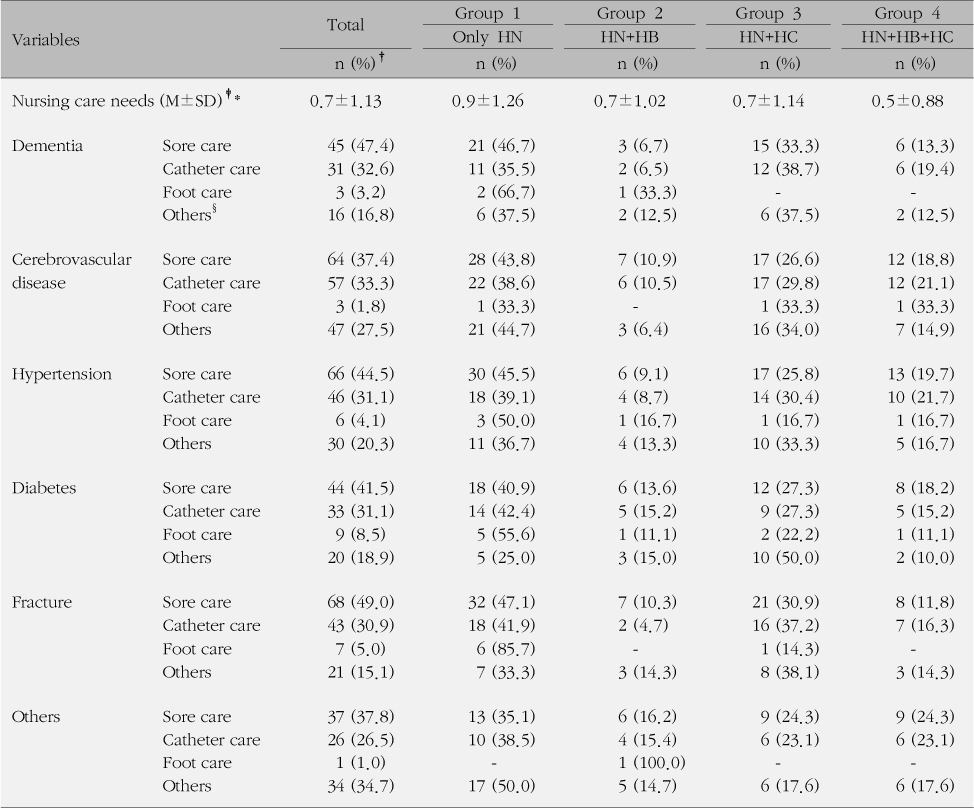Articles
- Page Path
- HOME > J Korean Acad Community Health Nurs > Volume 22(1); 2011 > Article
-
Original Article
- The Characteristics and Service Utilization of Home Nursing Care Beneficiaries Under the Korean Long Term Care Insurance
- Jung-Suk Lee, Eun-Jeong Han, Im-Ok Kang
-
Journal of Korean Academy of Community Health Nursing 2014;22(1):33-44.
DOI: https://doi.org/10.12799/jkachn.2011.22.1.33
Published online: April 4, 2014
1Senior Research Fellow, Institute for Health Insurance Policy Research, National Health Insurance Corporation, Korea.
2Researcher, Institute for Health Insurance Policy Research, National Health Insurance Corporation, Korea.
3Research Professor, Department of Medical Law & Ethics, Yonsei University, Korea.
© 2011 Korean Academy of Community Health Nursing
This is an Open Access article distributed under the terms of the Creative Commons Attribution Non-Commercial License (http://creativecommons.org/licenses/by-nc/3.0/) which permits unrestricted non-commercial use, distribution, and reproduction in any medium, provided the original work is properly cited.
- 602 Views
- 1 Download
- 15 Crossref
Abstract
-
Purpose
- This study examined the characteristics and service utilization of home nursing care beneficiaries under the Korean Long-Term Care Insurance (LTCI).
-
Methods
- We used assessment data and claim data of National Health Insurance Corporation from July to August 2008. Data were composed of subjects who were the beneficiaries of home nursing care.
-
Results
- A total of 634 subjects were analyzed. Of the subjects, 57.1% were 75 years and over. The average score of nursing care need was only 0.71 and the percentage of those whose nursing care need score was zero was 58.0%. More than half of the subjects had partially dependent musculoskeletal conditions, and 75.5% had two or more comorbidities. A third of them usedonly home nursing care, and another third used both home nursing care and general home care at the same time. Those who needed sore care used the largest home nursing care benefits.
-
Conclusion
- Home nursing care of LTCI performs community-based healthcare services under LTCI. Throughout the past two years, however, it has not been active. Understanding the characteristics of its users is important in order to develop effective strategies for activating home nursing care.

LTCI=Long-term care insurance; HN=home nursing; HB=home bathing; HC=home care.
†Others mean national medical aid and low income blanket. The persons in low income blanket were beneficiaries having a subsidy regularly from Korean government; ‡The region is classified according to the administrative district and region's population size. Small city means locations mixed urban area and rural area; §Persons in class 1 have worse functional conditions than class 3; ∥Sample size varies because participants of study have several diseases. The percentage means number of persons in each group among persons with the disease.
*p<.05.

HN=home nursing; HB=home bathing; HC=home care.
†This value is number and percentage of fully dependent activity. Score range of activity of daily living items is 13~39. The higher score means worse conditions; ‡Score range of musculoskeletal conditions is 10~30. The higher score means worse conditions.
*p<.05.

HN=home nursing; HB=home bathing; HC=home care.
†Sample size varies because participants of study have several diseases. The percentage is calculated as persons with the disease in each group is divided number of persons having each care; ‡Total score of nursing care needs is calculated as number of persons have nursing care needs. Score range is 0~10, The higher score means more nursing care needs(M±SD); §This is included tracheostomy care, suction, oxygen therapy, tube feeding, pain control, colostomy care and dialysis care.
*p<.05.

LTCI=Long-term care insurance; HN=home nursing; HB=home bathing; HC=home care.
†This means expenditure for each nursing care per month; ‡This is calculated as paid money for home nursing divided total charge; §This is included tracheostomy care, suction, oxygen therapy, tube feeding, pain control, colostomy care and dialysis care.
- 1. Bang EJ, Yun SY. Health needs of the elderly in long-term care facilities: using RAI-MDS-FC. J Korean Acad Community Health Nurs. 2010;21(2):263–272. Article
- 2. Chang HS, Chin YR, Kim JE, Hong EJ, Yu JS. The role and function of home healthcare based on the public health canters, hospitals, and long-term care insurance (06-75). Seoul: Korea Health Industry Development Institute, Management Center for Health Promotion; 2007.
- 3. Jung KH, Oh YH, Seok JE, Doh SR, Kim CW, Lee YK. 2004 Survey on use of welfare services and needs of welfare for the elderly among the aged in Korea (2005-03). Seoul: Korea Institute for Health and Social Affairs, Ministry of Health and Welfare; 2005.
- 4. Kang EJ, Kim NY, Kim DJ, Kim HR, Byun YC, Suh MK, et al. In-depth analyses of the national health and nutrition examination survey: The health interview and health behavior survey part. Seoul: Korea Centers for Disease Control and Prevention, Korea Institute for Health and Social Affairs; 2007.
- 5. Kim MH. Roles of visiting nurses defined based on long-term care insurance regulation for the elderly. J Korean Acad Public Health Nurs. 2009;23(2):232–250.
- 6. Kim EK, Kim YM, Kim MA. Estimation of nursing costs based on nurse's visit time for long-term care services. J Korean Acad Nurs. 2010;40(3):349–358. ArticlePubMed
- 7. Korea Statistics Office. Population projections for Korea 2009. Daejeon: Author; 2009.
- 8. Lee JS, Han EJ, Kwon JH, Kang IO. The correlation between standard long-term care plan and long-term care utilization under LTC insurance system (2008-33). Seoul: National Health Insurance Corporation; 2008.
- 9. Lim JG. A study on factors of home and community care service utilization of elderly. Korea Soc Policy Rev. 2009;16(1):193–234.
- 10. Ministry of Health and Welfare & National Health Insurance Corporation. The collection of long-term care insurance laws. Seoul: Author; 2008.
- 11. National Health Insurance Corporation. 2008 Manuals of working for long-term care insurance. Seoul: Author; 2008.
- 12. National Health Insurance Corporation. 2008 Long-term care insurance statistical yearbook. Seoul: Author; 2009.
- 13. National Health Insurance Corporation. 2009 National health insurance main statistics. Seoul: Author; 2010-a.
- 14. National Health Insurance Corporation. 2009 Longterm care insurance statistical yearbook. Seoul: Author; 2010-b.
- 15. Park CS. Visiting nurses' services under the long-term care insurance system for the elderly. Nurs Sci. 2009;21(1):64–72.
- 16. Sunwoo D, Kim CW, Choi JS, Choi HJ, Yeon BK, Won CW. The assessments for the second pilot project of long-term care insurance-needs of long-term care, system of admission long-term care insurance and supporting system for use of long-term care (2007-22). Seoul: Ministry of Health and Welfare, Korea Institute for Health and Social Affairs; 2007.
- 17. Song CR, Kang IO, Kim YO, Jo HS, Hwang MS. An analysis of the elderly care and management in hospital-based home care agencies. J Korean Acad Community Health Nurs. 2008;19(4):660–672.
- 18. Ryu HS, Park CS, Kim EY. A review on home health care in Korea-hospital, community, and public health center based home health care nursing. J Korean Acad Soc Home Care Nurs. 2007;14(2):65–75.
- 19. Ryu HS. Home health care in Korea-home health care nursing, visiting health care nursing, visiting health care. J Korean Acad Soc Home Care Nurs. 2007;14(2):98–105.
Figure & Data
References
Citations

- Willingness to Use and Appropriate Payable Cost for Visiting Nurse Service for the Elderly in the Community
Soyoung Seo, Soong-nang Jang
Journal of Korean Academy of Nursing.2022; 52(1): 105. CrossRef - Emergencies in Long-Term Care Services for the Elderly in Korea: A Mixed-Methods Study
Soon Ok Kim, Sun Hee Bae
International Journal of Environmental Research and Public Health.2019; 17(1): 66. CrossRef - Powerlessness, Family Support and Health Promoting Behavior in Elders Using Home Service under Korean Long-term Care Insurance
Yanghee Pang, Oksoo Kim
Journal of Korean Gerontological Nursing.2017; 19(3): 184. CrossRef - Association between home-visit nursing utilization and all-cause hospitalization among long-term care insurance beneficiaries: A retrospective cohort study
Yeong Jun Ju, Hyo Jung Lee, Woorim Kim, Sang Ah Lee, Kyu-Tae Han, Eun-Cheol Park
International Journal of Nursing Studies.2017; 75: 93. CrossRef - Effects of Visiting Nursing Services in Long-term Care Insurance on Utilization of Health Care
Sangjin Lee, Chanyeong Kwak
Journal of Korean Academy of Community Health Nursing.2016; 27(3): 272. CrossRef - Economic Effect of Home Health Care Services for Community-dwelling Vulnerable Populations
Eunhee Lee, Jinhyun Kim
Journal of Korean Academy of Nursing.2016; 46(4): 562. CrossRef - Regional Comparison of Home Visiting Care Service Satisfaction among Elder Beneficiaries of the Long Term Care Insurance
Chanyeong Kwak
Journal of Korean Academy of Community Health Nursing.2016; 27(2): 114. CrossRef - The Barriers and Solution of Providing Long-term Care Services at Home for the Beneficiaries with Mild Dementia: A Focus Group Interview
Mi Sook Song, Kyung Sook Lim
Journal of Korean Public Health Nursing.2016; 30(2): 259. CrossRef - Policy Implications for Home-Visit Nursing(HVN) of the Korean Long Term Care Insurance through the implications of the Japanese HVN
Hosihn Ryu, Kumi Arita
Journal of Korean Public Health Nursing.2015; 29(3): 403. CrossRef - Plan for Invigoration of Visiting Nursing Center in Long-Term Care Insurance for the Elderly - Through SWOT Analysis -
Do Hwa Byeon
Journal of Korean Public Health Nursing.2015; 29(2): 203. CrossRef - The Effects of Visiting Nursing Services in Long-term Care Insurance: A Difference-in-Difference Analysis
Jieun Kim, Insook Lee
Journal of Korean Academy of Community Health Nursing.2015; 26(2): 89. CrossRef - The Relationship between Home-Visit Nursing Services and Health Care Utilization among Nursing Service Recommended Beneficiaries of the Public Long-Term Care Insurance
Sae Bom Kang, Hongsoo Kim
Health Policy and Management.2014; 24(3): 283. CrossRef - Importance and Performances of Visiting Nurse Services Provided under the Long Term Care Insurance System for the Elderly
Do Hwa Byeon, Hye Jin Hyun
Journal of Korean Academy of Community Health Nursing.2013; 24(3): 332. CrossRef - The Experiences of Family Caregivers under the Long-term Care Insurance
Eun-Young Kim, Ga Eon Lee, Sam-Sook Kim, Chun Yee Lee
Journal of Korean Academy of Community Health Nursing.2012; 23(4): 347. CrossRef - Trends in Home-visit Nursing Care by Agencies' Characteristics under the National Long-term Care Insurance System
Jung Suk Lee, Rah Il Hwang, Eun Jeong Han
Journal of Korean Academy of Community Health Nursing.2012; 23(4): 415. CrossRef

 KACHN
KACHN
 PubReader
PubReader Cite
Cite

